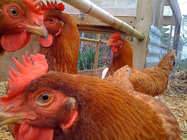There are many sources of low maintenance high yield stocks.
GOATS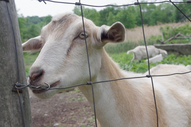 Goats are curious
Again goats are a source of protein through meat but they also provide another source of food in their milk. Usually goats get a bad rap for their milk tasting bad but this is not always the case, a lot of that is do to diet and whether or not a male goat (a buck) is present. Goats milk can be rich and creamy and used to make so many other things like cheeses and yogurts and ice cream and so on. Goats are a little more trickier to raise then chickens but again it just comes down to shelter and food, water and a closed off area to raise them. They are grazers but they will do fine in smaller areas with ample food provided. There are over 300 breeds of goat all bred for different reasons from wool harvesting to meat and milk production to packing gear in and out of remote places. So do your research before you get your goat. On average a female goat (a doe) can produce 3 liters or 3 quarts of milk a day for a 10 month lactation period then they take 2-3 month break. On average a goat will live up to 18 years. In order for a goat to milk she will have had to have given birth, this is called "Freshened" at this time she will produce milk for you as long as you continue to milk her on a regular basis which is daily for her lactation cycle (10 months on average). Goats are generally calm and gentle animals that like interaction but sometimes they can get an attitude, but can't we all.
USDA Dairy Goats General goat info-PDF |
|
Mushrooms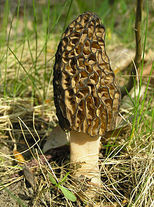 Wild Morel Mushroom
Mushrooms straddle the human consciousnesses from these amazing side dishes that are full of flavor and goodness to poisonous fungi that will kill you dead in minutes. The fact is that there are mushrooms that will kill you but these are few and far between, but still they are there and they do exist, so if you're thinking about picking wild mushrooms you better know what you're doing or be with someone that does. On the other hand many strains of mushrooms can be raised and harvested intentionally- Shitakie, Oyster, Morels, Buttons, Chanterelles and many more are available to you to be raised in a controlled environment. Most of these can be grown in a dark damp basement or even a bucket full of coffee grinds, the nutritional value of mushrooms is remarkable and it is a worthy study of anyone with the will to do so. On average specialty mushrooms can run from $20 to $200 a pound. The medical field is making discoveries daily as to the medicinal values of some strains of fungi. With a little legwork and research you can turn a little hike in the woods into a fungle find of delicious goodness. Take the warnings of your youth to heart though, mushroom can make you sick and even kill you. But once you know what you're looking for you're good to go on a Mycological manifestation of pleasurable proportions. There are Fungle freaks in your area right now that are more than happy to share the knowledge and wealth of fungi fascination with newbies and pros alike. Local clubs plan outings and information meetings for their members on a regular basis. Start with a search in your area for mushroom clubs or go hear to get started.
NAMA <North American Mycological Association. Also find more info at: Mushroom Council.org OG |
|
FISH (water chickens)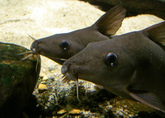 Catfish
You've heard the old saying like shooting fish in a barrel, well there is a reason for that saying. Raising fish in your back yard is easy and fun. You don't need allot of room for this either, 2- 50 gallon drums a filter and an air supply is pretty much it. You will pay pennies on the dollar for your harvest compared to grocery store prices. The most common fish used to raise in a barrel is catfish and tilapia because of their hardiness and flavor. Ideally if you have a pond on your property this is the way to go but a couple of barrels will do too. The barrels should be kept out of direct sunlight and if you live in a colder climate you will need an aquarium heater in the winter months or move them inside. If you take the notion to build a worm bed to raise your own worms then you have solved half of your feed problem right there. The fish will also need other sources of food like pellets and vegetation that can been grown in the tank. 20 to 30 fish can be raised per barrel. Fresh water will need to be added regularly but other then that it is a fairly easy process out side of feeding they just do their own thing. You don't have to use barrels and the bigger the better because the more fish you can raise. If you incorporate this with an aquaponics system you wont need to add fresh water and you will have fresh vegetables to eat as well. Find the "BarrellPonics" PDF in our >"LIBRARY"< to learn how to build your own aquaponics system at home.
DISCLAIMER P.S. Don't actually shoot the fish in the barrel because you'll put a hole in the barrel and then the water will leak out and your fish will die. |
|
COWS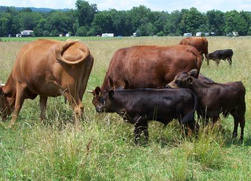 DEXTER cows
Most people think that cows are big cumbersome behemoths that need a lot of acreage and food to maintain and for the most part they are right, except for the exception of one smaller breed of cow known as the DEXTER cow. Small and compact these milk machines barley take up any land at all comparatively to their larger kin. Able to produce up to 2.5 gallons of milk a day they are the perfect fit for the smaller farm of self sufficiency. If butchered the meat is lower in cholesterol and tasty and tender, expect upwards of 350 to 400 lbs of meat from a mature cow. The Dexter is not a miniaturized breed like some other fad cattle of recent. The Dexter's heritage is a long and proud one originating in the tough conditions of Ireland's landscape and slowly making their way around the world as a prized animal to have, almost facing extinction after world war 2 the herds numbers have been returned to a healthy and stable count world wide do mostly to their value of production and ease to raise.
Mother earth news on-> Dexters. More info-> Dexter cattle assoc. |
|
BEES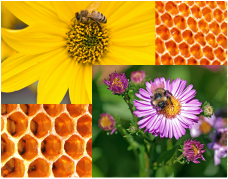
“If the bee disappeared off the face of the earth, man would only have four years left to live.” – Albert Einstein
Anthophila is their scientific moniker but we just know them as bees. Bees are nature's messengers carrying out valuable pollenation through out the vegetation system. Bees have two sets of wings, did you know that, one larger upper set and a smaller lower set. Up to 1/3 of the food consumed by humans is dependent on the pollination of bees. Pollination is not the direct objective of the bee but collecting nectar from the flowers for survival is, the flowers production of nectar serves no other purpose other then to attract the bee, bees are veracious eaters, they burn allot of energy moving around. The rapid movement of there wings combined with their fuzzy fur like coat creates a build up of static electricity which causes the pollen to stick to them as they make their rounds collecting nectar there by transferring the pollen around to different flowers. After their ability to sting, bees are known most for their beautiful bounty we call honey. The term worker or busy bee is no joke, these little guys or I should say girls( because the males don't really do anything in the hive other then eat and have sex) truly are work machines day and night, they build hives, collect nectar for honey processing, maintain the Queens health and happiness and build honey combs to have more baby bees in and then after the baby bees are born they store honey in the empty comb to eat during the winter months at which time all of the worker bees surround the Queen bee in a swarm to keep her warm to keep her alive. The hole flower nectar to honey thing is a miracle of nature for sure but I think we all get it, but do you know where the wax comes from that the honey comb is made out of? Bees secrete the wax through 8 wax glands located on their sternite (stomach). At first it is a clear liquid that they mold into place before it hardens. The bee hive will produce approximately 1 pound of wax for every 8 pounds of honey, In order to produce 1 pound of wax the bee hive collectively will have to have flown over 50,000 miles, the earth is approximately 25,000 miles around. One bee will visit up to 100 plants on an outing and on average they will make 10 trips a day so that's about a thousand stops a day in their short 4 week life span. A bees wings flap approx. 11,400 per minute. The average bee in a life time will produce about 1/12 of a teaspoons of honey, with 20 to 80 thousands (and even more in some hives) bees per hive that 1/12 teaspoons adds up. Everybody loves and if you know someone that doesn't you should call the I.N.S. and report them because they are from another planet. Honey is used for so many different things from an antibiotic to a sweetener and everything in between and oh ya! if you mix it with some water and yeast you can make your own MEAD just like they did in the olden days, here's how- MAKE YOUR OWN MEAD< Get more info on the amazing bee at the The National Honey board <linkBEE .S |
|
DIY-BEEHIVE in a jar
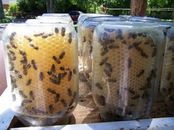
It seems everyone is interested in how to make your own beehive in a jar. Have the rows of organic honey jars at the farmers market got you thinking about starting your own backyard beehive? If you live in a suburban area, you may think that starting a beehive cannot be done. However a common suburban backyard can be a perfect place for beehives if done correctly and you do a bit of research and (more)
If you really want to save the planet, you better start with the
|
Watch a clip from Louie Schwartzberg's amazing Pollination movie. |
SNAILS
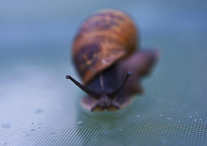
Wow! I love escargot, but it is so expensive and it comes from some mystical realm off in the fog somewhere that only the enchanted ones are allowed to visit and harvest at the snail kings approval, "WRONG" that $25 plate of escargot that is sitting in front you probably came from less then 50 miles away from where you're are sitting and the shell that it is in is most likely a fake acrylic reusable shell that gets ran through the dish washer after you are done eating and the plate is cleared from the table. There is no mystery to escargot, these are some of the same snails that are crawling around in your garden right now, they are known scientifically as Helix pomatia sometimes called apple snails or burgundy snails but mostly referred to as Roman snails because yes they are from Rome. Originally the Roman army carried them through out the known world on their crusades because of their light weight and ease of breeding, packing a power punch of protein and good flavor it was just a no brainer, but in doing so they populated most of Europe with these sometimes burdensome creatures. A swarm of these little guys can destroy a garden in days but at the same token when properly controlled they help to make it a healthy one as well by turning over soil and aerating the ground much like worms do. The eating of snails caught on quickly everywhere that the Romans went and became a staple across the land. When Europeans began to immigrate to America they brought their little low maintenance high protein buddy's with them and now they are pretty much a common site in all gardens across the country. Their close relative is known as the Helix aspersa and this is the more common of the two, also known as the "Brown garden snail or petite gris" they are notorious for the damage that they can do to a garden. Both are edible and delicious but the Helix pomatia is preferred over the helix aspersa. With some consideration they are easily bred and harvested in snail cages and there is a market for them in United States if you want to go to that level, most people breed them for personal consumption or for feed for other animals such as chickens and fish farms. They are a funny sort, some people pay to get rid of them and others pay to keep them.
Snail Farming
U.S. Department of Agriculture
WORMS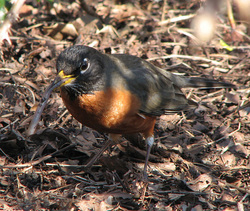 A robin eats a tasty Earthworm
Nobody loves me, every body hates me, I think I'll eat some worms. When you think of worms you think of slimy and disgusting things that crawl around on the ground but the fact of the matter is if you really think about it they are fat and juicy just like a steak and I personally have eaten many of them, OK that's a lie I have never eaten a worm but if I had to I would. They are full of protein and nutrients and are a major source of food for the animal kingdom. I have seen many people eat a worm either on a dare or the loss of a bet or just because they wanted to and nothing bad ever happened to them other then maybe to their social lives. I used to live next store to an Asian family in the city and I would watch them pick worms every night with their head lamps all summer long and I mean they would pick them by the hundreds and thousands and they weren't catching that many fish, although on that note they would catch allot of fish too. Every morning the grandfather would go out back to the garage and fire up a big soup pot and slow cook something all day and then at dinner time two people would go out and get the big pot and carry it in the house and then the next morning Grandfather would carry it out again and start all over. I am not 100% sure which country they were from but I do think I know, but I am not going to mention it here because I am not trying to cast a stereo type and If I was trying to cast a stereo type here it would be about those people, you know the ones I am talking about, those self sufficient type's, ya they're the ones all right, we don't want those kind in our neighborhood that's for sure, who do they think they are living off the land and eating good natural food, we'll have none of that going on in these parts, if it doesn't come in a can or a box we'll have nothing to do with it. Earthworms are made up of over 70% protein and they are a great source of Omega3 as well they will help to reduce cholesterol unless you fry them. Eaten the world over by many peoples they are a major food source and are considered a delicacy. All special forces and survivalist are taught of the importance of worms and insects in their daily protein diet, and your chickens will love them too.
WARNING:
Worms are susceptible to the soil they are in and consuming. Therefore if the soil is infected with pathogens most likely so are the worms consuming it. This would include E. coli and salmonella. Here are some more interesting facts and know-how about Earth-Worms. EARTHWORMS WORM BREEDDING FOR DUMMIES BEGINNERS GUIDE |
|
